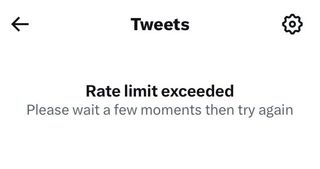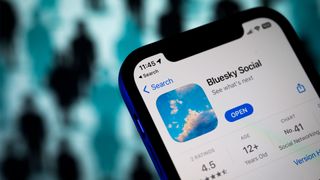Twitter crisis explained: what are rate limits and when will they end?
Rate limit exceeded, ad revenue conceded

The saga of Elon Musk’s Twitter acquisition has been long, arduous, and frankly a bit wild: from scrapping legacy blue checkmarks to raising the character limit to 10,000, the eccentric billionaire has been shaking things up at the social media platform, and it’s not always gone well.
The latest development could be the final nail in the coffin for Twitter, however, as Musk announced on Saturday, July 1, that users would be limited to viewing a set number of posts. Verified users will be allowed to see 6,000 tweets per day, while unverified users get just 600. New accounts that aren’t verified will get to view just 300 posts per day.
To address extreme levels of data scraping & system manipulation, we’ve applied the following temporary limits:- Verified accounts are limited to reading 6000 posts/day- Unverified accounts to 600 posts/day- New unverified accounts to 300/dayJuly 1, 2023
Since Musk delivered this news in a tweet (as is tradition, at this point), it’s fairly unclear as to what actually constitutes a ‘view’ or a ‘post’ - interestingly, Musk didn’t use the word ‘tweet’ at all in his announcement.
Replies appear to count towards the limit, but ads might not; and as for what ‘viewing’ a post means, as far as we can tell you could scroll past it at lightspeed and Twitter will still consider it viewed. Hit your limit, and you’ll get either empty space or a message that reads ‘rate limit exceeded’.
Musk was quick to raise the limits to 10,000 for verified and 1,000 for unverified users, but the new rules are enough to severely hobble the user experience for anyone not willing to shell out (from) $8 / £9.60 / AU$13 a month for a Twitter Blue subscription. Users are already reporting hitting their limit after a relatively short amount of time spent scrolling through their timelines, and these limits appear to be having a much larger impact than the previous tweet limits applied earlier this year.
Why is this happening?
Although Musk claims that the new limits are to deal with “extreme levels of data scraping & system manipulation” (whatever that means), it’s possible that there’s a more direct cause behind the scenes – one that could be entirely the Tesla CEO’s fault.
After taking over as CEO, Musk fired a large portion of Twitter's workforce and notably also stopped paying for a number of services used by the social media giant, including (amusingly) rent on some of its physical offices. A critical bill that went unpaid for too long was owed to Google for the use of its cloud hosting services, as reported last month by Insider.
Get the best Black Friday deals direct to your inbox, plus news, reviews, and more.
Sign up to be the first to know about unmissable Black Friday deals on top tech, plus get all your favorite TechRadar content.
Twitter relies on Google’s platform for a great deal, and some are claiming that the relationship breakdown between Musk and Google is the cause for Twitter’s current instability – although this hasn’t been officially confirmed, and it looks like Twitter did actually pay at least some of its debt after new CEO Linda Yaccarino took over.
"This is hilarious. It appears that Twitter is DDOSing itself."https://t.co/BM1QKwaW8Z pic.twitter.com/sBPauhS71mJuly 1, 2023
Another potential explanation, as noted by web developer and Twitter user Sheldon Chang, is that Twitter is essentially DDOSing itself. Chang noted early on Saturday that the Twitter home feed wasn’t loading properly, but that Twitter was still firing off non-stop requests for data that never arrived, resulting in constant instability.
Chang speculated that this was due to Musk’s most recent change: forcing users to log in before they could view any content on Twitter. This is an unpopular but not uncommon move for a social media platform; Instagram, for example, typically won’t let you view more than one linked post in your phone browser before asking you to open the app. Chang described the situation as "the most epic of self-owns".
When will it be fixed?

The short answer here is that we have no idea. Since Musk massively reduced the size of Twitter’s software engineering team, it’s entirely unclear when exactly Twitter will be able to resolve the issue, so these rate limits could remain in place for the foreseeable future.
Limiting the number of posts users can view for a longer period could have serious implications for Twitter’s revenue. The social media site’s primary source of income is from advertisers, and those ads need to be seen for Twitter to actually make money. Limiting access to a platform you’re trying to sell ad space on is a bizarre move, even for Musk.
Man in Donut Shop.“A dozen donuts please!”“Sure”Comes back a hour later “A dozen donuts please!”“Sorry, no”“There are dozens of donuts behind you”“I can’t serve you and all these other people at the same time.”“You just handed that guy a donut”“He’s paying extra”Leaves. pic.twitter.com/DaxROsLTMOJuly 1, 2023
Sadly, this fresh debacle is just another problem for the new CEO to slog through. There’s always another fire to put out, whether it’s potential fines from regulatory bodies or screwing over third-party API developers – the latter of which was a move aped by Reddit, resulting in the recent Reddit blackout. Why anyone would want to mimic Musk’s comedy routine is, quite frankly, beyond me.
Where do we go from here?
Confidence in Twitter is at an all-time low, and it’s not entirely due to the things Musk has actually done – sometimes, just the promise of some terrible new addition is enough to spook people.
During his short stint as CEO, Musk built something of a reputation for planning but not actually implementing new features, like disabling TweetDeck for non-paying users or the rumored call functionality that could have made the app unusable for women and minorities.

As for what we should be doing next, well… I’d like to say leave, but we’ve yet to see a real alternative arrive. Meta has a rival app in the works but it’s not available yet, and decentralized social network Mastodon has largely failed to capture the hearts and minds of Twitter refugees.
Jack Dorsey’s Bluesky app is a potential contender, but the platform is currently invite-only; naturally, people are already begging for invites on other social media sites. What happens next is anyone’s guess. There’s every chance that Yaccarino could turn things around at Twitter, but I personally won’t hold my breath – not as long as Musk still has one hand on the wheel, anyway.

Christian is TechRadar’s UK-based Computing Editor. He came to us from Maximum PC magazine, where he fell in love with computer hardware and building PCs. He was a regular fixture amongst our freelance review team before making the jump to TechRadar, and can usually be found drooling over the latest high-end graphics card or gaming laptop before looking at his bank account balance and crying.
Christian is a keen campaigner for LGBTQ+ rights and the owner of a charming rescue dog named Lucy, having adopted her after he beat cancer in 2021. She keeps him fit and healthy through a combination of face-licking and long walks, and only occasionally barks at him to demand treats when he’s trying to work from home.
Most Popular


